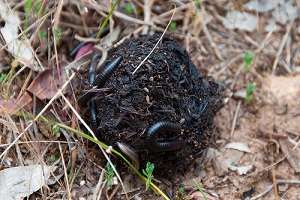Dr Baker says the species was first detected in Australia at Port Lincoln, South Australia, in 1953, and did not arrive in Perth until the early 1980s. Credit: Paul Asman and Jill Lenoble
An invertebrate ecologist says a recent low-speed train collision in Perth attributed to Portuguese millipedes (Ommatoiulis moreleti) on the tracks is a symptom of growing millipede numbers in WA.
Dr Geoff Baker says we can expect to see more millipedes in Perth and the South West, similar to the 1970s South Australian experience.
"It was invading houses in huge numbers and creating a hell of a nuisance problem to people," he says.
"When the autumn rains come and the season breaks the millipedes get really active, they're about to breed, and they are wandering everywhere.
"Then in spring there's a minor surge of activity."
He says their populations increase for several years after entering a new area, eventually resulting in plagues of the tiny invertebrates entering homes and causing trains to slip on their tracks.
After these plagues most individuals die, leaving a smaller, more stable population.
"If we are patient it will get better," Dr Baker says.
"There's a wave of abundance that comes through about ten years after they first establish in an area and they spread themselves by their own pace … only about 100 – 200 metres a year.
"Then they boom up in numbers and then they bust.
"They never go away but they settle down to a lower abundance.
He says the species was first detected in Australia at Port Lincoln, South Australia, in 1953, and did not arrive in Perth until the early 1980s.
He first identified the exotic pest for his PhD studies in the 1970s, and later predicted the species would spread over large areas of southern Australia that had a suitable Mediterranean climate.
The CSIRO first employed Dr Baker in Europe, where he spent several years investigating biological controls.
He says while the millipedes had many predators and parasites, most were not suitable introductions to Australia.
He finally found a fly (Pelidnoptera nigripennis: Diptera, Sciomysidae) that lays its eggs on living millipedes.
When the eggs hatch, larvae burrow into the millipede, killing it.
However controlled releases of the fly in South Australian proved ineffective.
Meanwhile, Dr Baker was able to test his hypothesis about the species' spread in Australia.
Acting as citizen scientists, school children who were members of the CSIRO "Double Helix Club" sent millipede specimens to Dr Baker in 2007.
He says this largely validated his earlier predictions about their geographic expansion, and formed the basis of a useful research collection.
The article "Invasions of the Portuguese Millipede (Ommatoiulis moreleti) in Southern Australia" has been peer reviewed and is to be published by Pedo-biologia international journal of soil biology. The authors are Geoff Baker (CSIRO Canberra), Linda Grevinga (University of Goettingen, Germany) and Natalie Banks (Murdoch University).
More information: www.sciencedirect.com/science/ … ii/S0031405613000413
Provided by Science Network WA
























